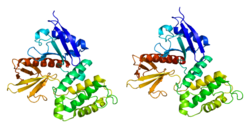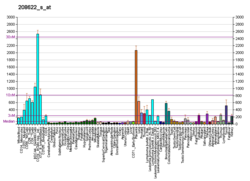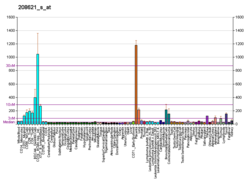Top Qs
Timeline
Chat
Perspective
Ezrin
Protein-coding gene in the species Homo sapiens From Wikipedia, the free encyclopedia
Remove ads
Ezrin also known as cytovillin or villin-2 is a protein that in humans is encoded by the EZR gene.[5]
Remove ads
Structure
The N-terminus of ezrin contains a FERM domain which is further subdivided into three subdomains. The C-terminus contains an ERM domain.
Function
The cytoplasmic peripheral protein encoded by this gene can be phosphorylated by protein-tyrosine kinase in microvilli and is a member of the ERM protein family. This protein serves as a linker between plasma membrane and actin cytoskeleton. It plays a key role in cell surface structure adhesion, migration, and organization.[6]
The N-terminal domain (also called FERM domain) binds sodium-hydrogen exchanger regulatory factor (NHERF) protein (involving long-range allostery).[7] This binding can happen only when ezrin is in its active state. The activation of ezrin occurs in synergism of the two factors: 1) binding of the N-terminal domain to phosphatidylinositol(4,5)bis-phosphate (PIP2) and 2) phosphorylation of threonine T567 in the C-terminal domain.[8][9] Binding to actin filaments (via C-terminal) and to membrane proteins (via N-terminal) stabilizes the protein's conformation in its active mode. The membrane proteins like CD44 and ICAM-2 are indirect binding partners of ezrin, while EBP50 (ERM binding protein 50) can associate with ezrin directly.[10]
Remove ads
Interactions
VIL2 has been shown to interact with:
References
Further reading
Wikiwand - on
Seamless Wikipedia browsing. On steroids.
Remove ads








